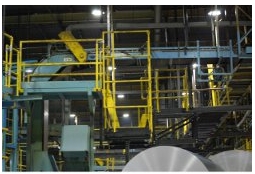As a leading consumer packaging company with 83 manufacturing sites across the globe, Rexam makes the packaging for many of the world’s favorite brands, striving to produce it as efficiently and sustainably as possible. Producing 4.5 million cans a day for the UK and Northern Europe at its beverage canning plant at Milton Keynes UK, the company decided to review its lighting at this facility in order to reduce energy consumption.

The Challenge
The Milton Keynes production line and warehouse are in constant use and the lighting runs 24/7. Because the company had previously had issues in two other plants with mercury vapor lamps, it had decided to enclose them all or change them out altogether. It therefore made sense to look at a new lighting solution that would save energy as well as meeting safety standards. (Shown right, high bays mounted at 8 meters above the production line.)
With 340 x 400 W mercury vapor high bays throughout the facility, energy costs were high, but maintenance was also a big consideration. At 8 meters mounting height, fittings above the production line were hard pressed to produce enough light because of film buildup from oil vapors in the atmosphere. The print area is also full of conveyors and gantries, which further filter the light as well as making the light fittings very hard to access. The mercury vapor high bay lamps were averaging a 2 to 3 year lifespan and were being replaced when they failed or looked ready to fail at a rate of around 40 a year. This often involved bringing in specialist hired riggers at a cost of £750/day.
The Solution
 Electrical supervisor Stuart Macey looked at 6 alternative lighting solutions from a variety of manufacturers, trying out samples over a 3 month test period, before choosing Dialight’s DuroSite® Series LED High Bays on the combined basis of price and performance. Rather than rewire the plant, he replaced the 400 W mercury vapors one-for-one with 150 W LED high bays throughout the production and warehouse areas. (Shown right, high bays mounted at 13 meters in the warehouse.)
Electrical supervisor Stuart Macey looked at 6 alternative lighting solutions from a variety of manufacturers, trying out samples over a 3 month test period, before choosing Dialight’s DuroSite® Series LED High Bays on the combined basis of price and performance. Rather than rewire the plant, he replaced the 400 W mercury vapors one-for-one with 150 W LED high bays throughout the production and warehouse areas. (Shown right, high bays mounted at 13 meters in the warehouse.)
The Result
Macey calculates that his lighting energy needs for the high bays have been reduced from 1,100 kWh to 433 kWh per year, a savinsg of £43,000 annually at a rate of £0.06/kWh, and estimates a payback period of a little over two years when comparing this investment in LED technology with the alternative solution of installing open-rated lamps to meet new corporate safety standards. He also notes that further savings can be counted from the reduced maintenance burden, thanks to Dialight’s continuous performance warranty.
To Macey’s surprise, the warehouse is where the LED high bays have brought unexpected benefit. Mounted at 11 to 15 meters in a palletized area with no aisles, they’ve been a major success.
“The lighting used to be poor, but now operators find the quality of light restful and good for the eyes – more like daylight,” he comments. “As this area is our last chance to check product quality, the lighting is important to us. We’ve had the LEDs in place for 18 months with no failures, so our high bay lighting is no longer a health and safety issue and this installation is now regarded as a best practice example for all our plants.”
Installation Snapshot
Replacement of 340 x 400 W MV with 150 W LED high bays
Over 60% reduction in energy needs
460 tons annual reduction in CO2 emissions
Expensive maintenance eliminated
Improved safety and productivity
Payback just over two years.
Dialight LED Benefits
L70 rated for >100,000 hours @ 25°C ambient
5 year full performance warranty as standard
10 year full performance warranty available (25,000 and 17,500 lumen models only)
Up to 102 lm/W
Significant energy savings
Instant on/off
Maintenance free
Mercury free
No UV or IR
Produces minimal heat compared to traditional fixtures
Reflector-based optics for precise light control
Resistant to shock and vibration
Temperature compensation technology for long life
Copper free aluminum
Typical payback < 2 years.





